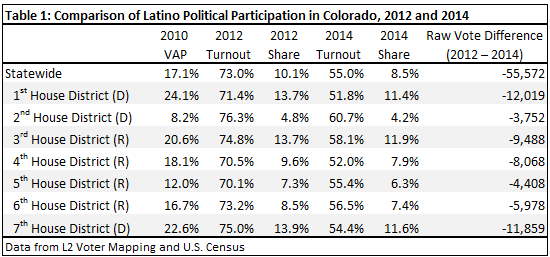This piece originally appeared at The Monkey Cage blog at the Washington Post.
Heading into the 2014 elections, much of the conventional wisdom suggests that Latino voters are unlikely to affect outcomes. Most notably, except for Colorado, there are no competitive U.S. Senate races where Latino voters are positioned to be influential. In U.S. House races, the Democratic Party’s poor recruiting and fundraising efforts in districts that were narrowly carried by Republicans in 2012 and have significant shares of voting-age Latinos means that many potentially vulnerable GOP House incumbents are getting a pass this cycle. As a consequence, the influence of Latino voters may be limited to a handful of mostly western House districts that were narrowly carried by Democrats in 2012.
In this analysis, I examine two such districts: Arizona’s 1st and 2nd to consider how immigration politics and the support of Latino voters could help the Democrats hold two of the party’s most vulnerable seats. The table below summarizes the districts’ demographic and political contours. Although there is sizable and growing Latino voting-age populations in both districts, voting-age whites are the majority. In 2012, the Democratic incumbents, Ann Kirkpatrick and Ron Barber, prevailed even though Mitt Romney narrowly won both districts. The latest registration figures indicate that the Democrats have a 26,605 advantage over the Republicans in the 1st, while there are roughly 4,000 more registered Republicans than Democrats in the 2nd. Still, voters unaffiliated with either party constitute a third of both districts’ registrants and in 2012 the Libertarian Party candidate took over 6 percent of the vote in the 1st–a not insignificant share in an election that was decided by less than four points.

Given these dynamics, the Republicans have made both districts a priority and both the National Republican Congressional Committee (NRCC) and the Democratic Congressional Campaign Committee (DCCC) have reserved substantial airtime in both districts. However, in the 1st, the NRCC complicated its prospects by including two Republicans, Gary Kiehne and Arizona House Speaker Andy Tobin, in its “On the Radar” program. In the primary, Tobin prevailed over Kiehne by less than 500 votes, while a third candidate, state legislator Adam Kwasman, took 29 percent. Because of the primary’s divisiveness and late date, Tobin will need to scramble to compete against Kirkpatrick, who is sitting on nearly $1.3 million. In the 2nd, retired Air Force Colonel Martha McSally is one of the NRCC’s “Young Guns.” McSally, who narrowly lost to Barber in 2012, has raised over $1.8 million, with $1.1 million in cash on hand.

Still, the districts’ geography, not to mention the saliency of immigration to Arizona politics, causes Kirkpartick and Barber to tread lightly. Like their GOP opponents, both stress border security, while Kirkpatrick also notes her support for the DREAM Act. More recently, Kirkpatrick and Barber voted against HR 5230 and HR 5722. Kirkpatrick received an 82 percent rating on the “2014 National Immigration Score Card,” while Barber’s rating is 73 percent — the lowest of the five Democrats in the Arizona House delegation. Yet, Kirkpatrick and Barber’s political survival may depend upon drawing sharp contrasts with their Republican challengers on immigration and mobilizing marginal Latino voters.
To this end, the tables below summarize the partisan distribution of registered Latino voters in both districts, sorted by their probability of voting as estimated by Latino Decisions and L2’s micro-targeting models. This methodology draws on insights gleaned from the roughly 15,000 interviews of Latino voters conducted by Latino Decisions during the 2012 election to model turnout, vote choice, and partisanship of the approximately 15 million Latino registered voters in the United States.
As these tables make clear, there are significant numbers of Latino voters in each district. Latino registration, however, lags behind voting-age population share. Moreover, although the vast majority of Latinos in each district are likely Democrats (74 percent in the 1st and 69 percent in the 2nd), our modeling indicates that just 40 percent of these voters have a high probability of voting in November. Or put differently, mobilizing the voters in the blue cells (e.g., the swing and low-probability Latino Democrats and Latinos not registered as either Democrats or Republicans) would increase the pool of Latino voters in each district who are either persuadable or who favor the Democrats by nearly 200 percent.
Yet, because these voters are, by definition, less politically engaged and, in many instances, receive information exclusively through Spanish language outlets, it is unlikely that the millions of dollars that will be spent on ads will reach these voters. Rather, as the relevant scholarly literature finds, far and away the most effective means to increase Latino turnout is through door-to-door canvassing and live telephone calls.
In sum, for Democratic candidates competing in districts such as these, there is no guarantee that being on the “right” side of the immigration issue will bring Latino voters to the polls. Mobilizing Latinos requires candidates to engage Latino voters and demonstrate an understanding and concern for these voters’ communities. Indeed, one of the key findings of Latino Decisions polling during 2012 was that the political participation of many Latino voters was driven by support for their communities. Failing to grasp this point could be the difference between victory and defeat for Kirkpatrick, Barber, and similarly situated Democrats.
David Damore is a senior analyst at Latino Decisions, Associate Professor of Political Science at the University of Nevada Las Vegas, and a Senior Nonresident Fellow in the Brookings Institution’s Governance Studies Program.




